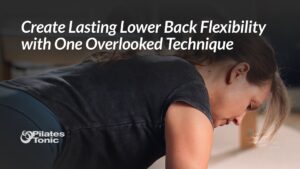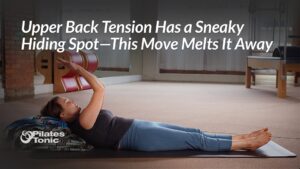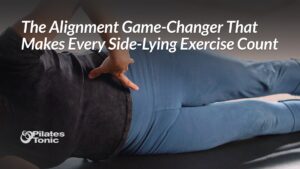
At the end of 2015, I received an email from a reader with questions about a post I wrote in 2012 called Three Ways Tucking Your Pelvis Can Hurt You.
She had some really great questions and I know she wasn't alone in wondering about this subject. This post is for you if you also want to understand the issues around tucking your pelvis and how to activate your glutes correctly.
If you follow along with me, you will learn the optimal way to move your pelvis for Pilates-based exercises and you will get far better results.
I teased out three main questions from the original reader email. I've paraphrased below:
- I have been a student of Pilates for a couple years and there are many mat and reformer exercises that say you should round your lower back and tuck your pelvis, even on some roller exercises for releasing hip flexors. Can you round the lower back without tucking?
- Why do some of the exercises I do also say to start by squeezing the sit bones?
- How do you activate your glutes without squeezing the sit bones?
These are excellent questions which, essentially, center around questioning the standard directive to tuck the pelvis in some exercises and whether it's possible to activate the glutes without squeezing the sit bones.
Let's Start with the first question about tucking the pelvis…
The first thing that's critical to understand is that you have to move your pelvis to get into these exercises, absolutely. In fact, the ability to move your pelvis and spine is vital for optimal mobility. The purpose of many Pilates exercises is to help maintain and regain this mobility.
However, the strategy you use to achieve these movements is what we want to investigate.
Move Your Pelvis without Squeezing Your Glutes
Ideally, when you move your pelvis for an exercise that requires a rounded lower back, you’re using your abdominals, most especially the deepest, lowest part of your rectus abdominis that attaches to your pubic symphysis (pubic bone).
You also want to know how to find a neutral pelvis and be able to move from neutral, through neutral, and back to neutral during these exercises. I show you exactly how to do this here: The Easy Antidote to a Misaligned Pelvis.
Most of Us Have Inactive Glutes
Our bodies adapt and grow based on how often and how much we use them. For a lot of us living in this Western culture, we've adapted to chronic sitting and wearing inflexible shoes with elevated heels from a young age. This leaves us with shortened psoas and hip flexor muscles, immobile feet, and internally rotated femurs.
These adaptations result in sleepy inactive butt muscles and it makes moving into and out of Pilates exercises darn near impossible. To compensate, we resort to distorted and ineffective movements and positions in order to make our bodies achieve the exercises. One of the most famous of these compensation strategies is squeezing the glutes together.
[x_image type=”thumbnail” float=”none” src=”https://pilatestonic.com/wp-content/uploads/2016/01/ari-will-syd-960x.jpg” info=”none” info_place=”top” info_trigger=”hover”]
The Problem Isn't Tucking, It's WHY You're Tucking
The problem is not so much tucking the pelvis, but that most people are tucking because they have lost the ability to stabilize their pelvis and are squeezing their glutes to compensate.
So, to answer your question, it's not that you don't want to move (or tuck) your pelvis for certain Pilates exercises, it's that you want to avoid squeezing your glutes together as the means to make your pelvis move.
Now, let's tackle the second question…
Why Do Some Pilates Exercises Say To Start By Squeezing The Sit Bones?
What is the intention of squeezing the sitting bones to start the exercise? Is it to activate or strengthen the pelvic floor? Is it to activate the glutes?
If you're trying to activate the glutes, or activate the pelvic floor, it’s important to understand a little bit about the pelvic floor and glute anatomy first.
Your pelvic floor consists of all the muscles and soft tissue that span the bottom of your pelvis. These muscles close up the hole at the bottom of your pelvis while providing support for your internal organs.
The pelvic floor muscles are also involved in going to the bathroom, childbirth and helping to maintain optimal intra-abdominal pressure. Men and women both have pelvic floors.
You want your pelvic floor muscles to be long, supple and taut.
Without the pelvic floor muscles, our insides would fall out of the bottom of our pelvis, so you can see why pelvic floor health is so vitally important.
Over-Cueing the Pelvic Floor Exacerbates Issues
In March of 2012, I took my first, of what would turn into many, workshops with Marie-José Blom. During this workshop, she said something that caught my attention and turned out to be the catalyst for a huge shift in my teaching approach. I can’t remember her exact words, so I’m paraphrasing here, but this is basically what she said:
[x_blockquote cite=”Marie-José Blom” type=”left”]Pilates is really getting a bad reputation in other industries outside of Pilates because of the over-cueing and incorrect cueing of the pelvic floor.[/x_blockquote]
I was heartbroken and shocked, at first. Pilates was my end all be all. Like many Pilates enthusiasts, I thought Pilates was the answer to everything.
But after the initial shock wore off, I committed to exploring what Marie-José said that day. It wasn’t long after I’d returned from that workshop that I received the first of many confirmations supporting what Marie-José had suggested.
A client with pelvic floor issues brought in a textbook written by Leon Chaitow with a page bookmarked. There, in black and white, Pilates was mentioned as a direct contributor to pelvic floor issues and the recommendation was to avoid Pilates altogether.
I wish I’d written the name of the textbook down that day. Unfortunately, I didn’t. However, a 2006 article about this same issue by Leon Chaitow covers similar ground: The Pelvic Floor Paradox.
Let's take a look at the final question…
How do you activate your glutes without squeezing the sit bones?
Consider the sitting habit I mentioned earlier. Not only are a large number of people sitting a lot every day, they are sitting on the back of the pelvis, which isn't designed to support the weight of the body.
Another common alignment issue I'm very familiar with (because I've been guilty of it!) is standing with the pelvis tucked under.
Both of these pelvis-tucked-under patterns leave the gluteal muscles unable to activate optimally and lead to a pelvic floor that becomes too tight.
When the pelvic floor muscles get too tight, and the gluteals are weak, the pelvic floor muscles can pull the sacrum out of alignment and into the bowl of your pelvis.
Now let's consider the cue of squeezing the sitting bones together. If your pelvic floor muscles are already too tight and pulling your sacrum out of alignment, intentionally squeezing your sitting bones together is going to exacerbate this problem.
Not to mention the fact that a lot of folks are just squeezing the glutes together when asked to squeeze the sitting bones together.
What's Wrong with Squeezing the Sit Bones to Activate the Glutes?
Our glutes help us walk, get up from chairs and even help keep our sacrum from collapsing into our pelvis.
In order for your glutes to activate optimally, your pelvis has to first be in a neutral alignment, with your ASIS (Anterior Superior Iliac Spine, located at the top and front of your hip bones), aligned vertically with your pubic bone.
Let’s look at what the glutes are designed to do:
- They assist in taking your leg behind you.
- Help take your leg out to the side and back.
- Laterally rotate your thighbone, or turn it out.
- They're used in forced extension, for example, to get up from a chair.
- Your glutes help prevent your sacrum from being pulled into your pelvis.
Looking at the glutes from this perspective, squeezing them together as a means to create strength doesn’t make very much sense, does it?
Exercises that move your leg on your pelvis while maintaining a neutral pelvis, or vice versa, make a lot more sense, in my opinion.
Do You Have the Muscle Length to Strengthen Your Glutes Safely?
Before any intentional glute strengthening is attempted, it’s important to establish whether you have the required muscle length necessary from your hip flexors to take your leg behind you without using your lumbar spine. For more on this concept, see this previous post: Assess Your Hip Flexors and Quads to Solve Back Pain and More
If you don't have necessary muscle length, then regaining hip flexor length is going to be the first step and key to creating lasting change when it comes to glute activation.
Building glute strength/tension on top of shortened and tight hip flexors will create a tug-of-war effect of muscle tension between the front and back of the pelvis, which isn't good.
It's Not How You Look, It's How You Move!
If your body has adapted to some of the common alignment problems mentioned above, moving your body to achieve many of the Pilates exercises optimally is going to be a challenge.
Sure, you're body will compensate to help you achieve the look of the Pilates exercises you're attempting, but you could be exacerbating issues or creating new ones.
Learning how to break down the big movements into the smaller movements that comprise them allows you to discover where you're missing mobility. Once you're aware of where your missing mobility, developing and regaining it is key to creating lasting change.
Remember, all of this requires a different perspective and the willingness to see that taking the time to embody the small movements and connections pays massive movement dividends in the long run.
2020 Post Update: Check out the videos linked below for more information and specific exercises for activating your glutes without squeezing!
The Best Glute-Strengthening, Sacrum-Stabilizing, Balance-Building Exercise Ever
As always, all questions are appreciated and answered in the comments below. I look forward to hearing from you!
See you in the studio,
Sydney





10 Responses
This is a fascinating article since I have historically had sacrum problems since falling down the stairs as a kid. These problems have lessened of late. Can my step aerobics class be helping? (I don’t use any additional risers so as not so exacerbate sacrum torque.) We seem to strengthen our glutes from a neutral spine, use the hip flexors all the time, and then we stretch them both gently at the end of the routine. I’d love to continue to do what helps and avoid what hurts. Thanks!
Hi Robin, If you’ve noticed that you feel better since starting the step aerobics class, it sounds like it’s helping.That’s great that they focus on working from a neutral pelvis. That makes a big difference! Thanks for sharing!
hey sydney,
fantastic read, although i couldnt exactly pinpoint in the article ‘how to activate the glute…’. Is the video not working ?
Hi Mishie, There wasn’t a specific exercise or video given for this post. I do anticipate future videos with more specific exercises.
Thanks for your feedback!
Understanding to be in neutral… I also didn’t see exactly a pinpoint or cue in the article on ‘how to activate the glute’ Did I miss something? When teaching group class and for example, doing the shoulder bridge exercise where a lot of students tuck here, would love some fresh cues to help with this move. Thank you for your work/time, it is truly appreciated.
Hi Gwyn, thanks so much for your feedback! In this post I didn’t mention a specific cue or exercise… you didn’t miss anything. 🙂 With regard to shoulder bridges, I’ll often cue people to sink their feet and barely hover their hips without losing neutral. Then, from the hover point, before lifting any higher, ask them to feel the back of their ribs and their sternum soften toward the mat as they exhale. Next, without thrusting the ribs continue lifting their hips into their bridge. They won’t be able to lift as high without simultaneously lifting their ribs, but I’ve found it really helps with glute activation to do it this way because they’re less likely to compensate with their lumbar spine.
Another approach is to connect the lift off of the pelvis with the movement of the sacrum and the breath. This video series takes you through some exercises to help sense this movement. I focus on applying the technique to a roll-down in the series, but it’s a really nice way to fine tune the movement of the pelvis into a bridge as well.
And here’s a bridge specific video you might also find helpful. If you try any of these out I’d love to hear how it goes!
I save your posts when life is really busy, but always get back to them at some point — today, for this one. Brilliant, and YES! As one who has left Pilates due to pelvic floor issues, this really speaks to the issue in a clear way, and I truly appreciate the understanding! Wish you weren’t so far away, and we could work together! All the best! I hope you keep up the great work! -Allyson
Thanks so much Allyson. I’t always great to hear from you!!
this is a great article – thank you so much for this easy to understand information!!
So happy you found it helpful, thanks for your feedback!